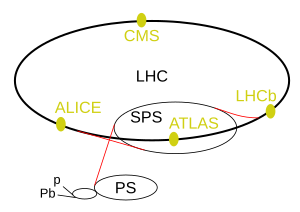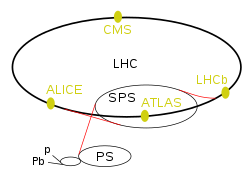Talk:Large Hadron Collider/Archive 2
| This page is an archive of past discussions. Do not edit the contents of this page. If you wish to start a new discussion or revive an old one, please do so on the current talk page. |
Amendments
loss of only 10−7 of ..... I suppose we aren't talkin apples but MJ here. I figure we could postfix and convert it straight in kJ?Slicky 07:11, 28 February 2006 (UTC)
Location?
I didn't see it listing anywhere the location of this facility...
It's in Geneva, Switzerland Turboyoshi 21:23, 23 April 2006 (UTC) Well, It is actually close to Geneva, but not in Geneva. Of course the circle spans quite an area between France and Switzerlandyanneman 00:36, 1 July 2006 (UTC)
LHC figure
I made a figure about LHC. I think that appropriate for this article. I made it's SVG version as well, but it didn't work well (my Firefox shows it correctly). -- Harp 15:35, 3 April 2006 (UTC)
Clarification requested
Is it a large collider of hadrons or a collider of large hadrons? This is not obvious from the article! Cheers -- SamSim 22:13, 23 May 2006 (UTC)
- It's a large collider of hadrons. Zargulon 22:28, 23 May 2006 (UTC)
- It's a proton collider more specifically, and protons only come in one "size." ;) -- SCZenz 15:22, 28 May 2006 (UTC)
- Technically, they're very small protons. The energy you make a particle, the smaller it gets.--Loodog 17:23, 31 May 2007 (UTC)
Science Collaboration of the Week
Hi all. I work on an LHC experiment, namely ATLAS, and I am happy to help with this article. I don't have infinite time, but there are three ways I can help:
- If there are specific pieces of information you need, or questions you have, I may know already where to find them.
- A significant amount of background information relevant to all of the LHC is in the ATLAS experiment article, which I brought up to featuerd status a while back. Perhaps some of it could be used/rewritten for the LHC more generally.
- I'm at CERN right now, so possibly I can go take some pictures if there's something for which a picture is needed. Bear in mind that I can't get better access to the experimental halls or tunnels than any member of the public, which is to say I'd have to apply for a tour. But do go ahead and ask if there's some specific thing you think would be cool; it may be such a picture can already be found in the public domain somewhere, too, and I'll know where it is. -- SCZenz 15:28, 28 May 2006 (UTC)
- Yes, please do take pictures. As long as you agree to release them under the GFDL, we need your pictures! The current one in the article is not very good for the purpose, so get snapping! —Vanderdecken∴∫ξφ 11:14, 6 June 2006 (UTC)
Template for LHC-experiments
What do you think, would it be good to put a template into the LHC-experiments like this:

| ||||
| ATLAS | CMS | LHCb | ALICE | TOTEM |
-- Harp 10:36, 30 May 2006 (UTC)
- Looks good (but I'm no judge as to accuracy, completeness etc.). Can we somehow discourage people from clicking the text in the picture, expecting to get to the respective articles? Make the font underneath bigger/bolder? Or if anyone knows how to implement the functionality of the "area" html tag here? - Samsara (talk • contribs) 10:44, 30 May 2006 (UTC)
I had a small trial to use area maps, I don't succeeded. I think it is hard, because the full image is a link. But if it is possible, I can change the text to a html-link like style. (The vector graphic (SVG) version is at the commons too, but it can't render the Wikimedia software perhaps because of the several layer. -- Harp 12:40, 30 May 2006 (UTC)
- It looks very nice. I disambiguated ALICE in the above. -- SCZenz 12:59, 30 May 2006 (UTC)
- Maybe something like the Germany map in World_Cup_2006#Venues could be tried. rbonvall 12:02, 19 July 2006 (UTC)
 Plan of the LHC experiments and the preaccelerators. | |
| LHC experiments | |
|---|---|
| ATLAS | A Toroidal LHC Apparatus |
| CMS | Compact Muon Solenoid |
| LHCb | LHC-beauty |
| ALICE | A Large Ion Collider Experiment |
| TOTEM | Total Cross Section, Elastic Scattering and Diffraction Dissociation |
| LHCf | LHC-forward |
| MoEDAL | Monopole and Exotics Detector At the LHC |
| FASER | ForwArd Search ExpeRiment |
| SND | Scattering and Neutrino Detector |
| LHC preaccelerators | |
| p and Pb | Linear accelerators for protons (Linac 4) and lead (Linac 3) |
| (not marked) | Proton Synchrotron Booster |
| PS | Proton Synchrotron |
| SPS | Super Proton Synchrotron |
Here is Template:LHC (at right). (I used some code from Template:Hadron colliders). -- Harp 09:21, 31 May 2006 (UTC)
I changed, I you like the shorter version, you can find it in the history of the template. But if you like the longer better, perhaps it would be usfeul to put the energies of linacs, PS, SPS... in the table. Any other suggestion? What is better word: preaccelerator or injector? I think only the previous one is the injector of the LHC, so I used the preaccelerator, but I don't know wheter it is an official phrase. -- Harp 10:29, 31 May 2006 (UTC)
I have put the template into the expertiment articles. I will put it into the LHC as well. -- Harp 08:56, 1 June 2006 (UTC)
I have a table about LHC. I have collected the facts I think could be mention in the article. Perhaps some of them should be in the template.
| Energy at collision | 7 TeV |
| Energy at injection | 450 GeV |
| Dipole field at 7 TeV | 8.33 T |
| Luminosity | 1×1034 cm-2s-1 |
| Current (proton) | 0.56 A |
| Bunch spaceing | 7.48 m |
| Bunch separation | 24.95 ns |
| Number of protons /bunch | 1.1×1011 |
| Luminosity lifetime (reduce to 1/e) |
10 h |
| Energy loss per turn | 6.7 keV |
| Total radiated power per beam | 3.8 kW |
| Stored energy per beam | 350 MJ |
Some parameters I think don't need to mention, or I don't know what means:
| Coil inner diameter, aperture (300 K) | 56 mm |
| Distance between aperture axes (1.9 K) | 194 mm |
| Beam beam parameter | 3.6×10−3 |
| Normalized transverse emittance (r.m.s.) | 3.75 μm |
| Total crossing angle | 300 μrad |
| Beam separation in arcs (1.9 K) | 194 mm |
Ref section
Per the MoS, I believe the section currently labeled as "references" should be labelled "Notes" and go to the end of the article. Perhaps the actual references for those can then be added back into the ref section. I'll double check the MoS and provide a link shortly. --DanielCD 03:22, 4 June 2006 (UTC)
Wikipedia:Footnotes and Wikipedia:Citing Sources. It seems to be a flexible policy, but I'll change the name of the section to "Notes and references" for now. If actual general refs are added, then we can make a separate section. --DanielCD 03:26, 4 June 2006 (UTC)
Popular culture references
Shouldn't some reference be made as to the prominence of the LHC and CERN in Dan Brown's book Angels and Demons? The mention of the accelerator creating antimatter, the theory of the process used etc. should be included. Not to mention the fallout that this gave CERN, redirecting concerns that antimatter had been made in 5 gram amounts that were not secured and so on. Many refernces can be found with our friend Google. —Vanderdecken∴∫ξφ 11:20, 6 June 2006 (UTC)
- It's covered in some detail in CERN. -- SCZenz 12:43, 6 June 2006 (UTC)
- I'm really sick of these stupid "pop culture" sections in Wikipedia. Can't geeks forgo their obsession with trivia and add only information that matters? -- 71.235.238.180
- Then they wouldn't be geeks. ;-) I oppose adding a popular culture section to any article. If there is something extremely relevant in popular culture about the subject, it can be worked into the rest of the article. -- Kjkolb 14:04, 7 November 2006 (UTC)
- I'm really sick of these stupid "pop culture" sections in Wikipedia. Can't geeks forgo their obsession with trivia and add only information that matters? -- 71.235.238.180
- No one cares about that terrible book Kupesoft 16:27, 1 December 2006 (UTC)
- What exactly is the link to Half-Life doing here? I honestly don't see how it's related. 84.250.41.125 (talk) 16:31, 1 January 2008 (UTC)
Loss and AD
"Loss of only 10−7 of the beam is sufficient to quench a superconducting magnet..." On what timescale? Per second, per hour...
LEIR, AD - I think it is an other story. The LHC don't need antiproton.
-- Harp 12:36, 13 June 2006 (UTC)
- I think it is not about the timescale. If only a portion (I don't know the correct ratio) of a single beam bunch gets out of the path and hits the magnet once, it is enough to quench the superconductor. þħɥʂıɕıʄʈʝɘɖı 09:03, 14 June 2006 (UTC)
I have updated the text on LEIR and removed AD as it is not involved with injection.
Scaler1112 16:11, 3 November 2007 (UTC)
LHC countries
- Armenia, Australia, Austria, Azerbaijan Republic, Belarus, Belgium, Brazil, Bulgaria, Canada, China, Croatia, Cyprus, Czech Republic, Denmark, Estonia, Finland, France, Georgia, Germany, Greece, Hungary, India, Israel, Italy, Japan, Korea, Morocco, Netherlands, Norway, Pakistan, Poland, Portugal, Romania, Russia, Slovak Republic, Slovenia, Spain, Sweden, Switzerland, Turkey, Ukraine, United Kingdom, United States, Uzbekistan
from http://lhc-machine-outreach.web.cern.ch/lhc-machine-outreach/components/lhc-manufacturing.htm
Updated LHC information
It might be interesting to know the startup program for the LHC, later and at lower energies than was previously believed. You can find good material for the article in that post. I'll add that link to the article Franjesus 18:29, 20 June 2006 (UTC)
LHC starting energy
The article says the LHC will start in November 2007, which is correct, but also "when it will become the world's largest and highest energy particle accelerator". This is not true. The latest LHC schedule foresees 450 GeV collisions in 2007. The full energy will only be achieved in 2008. Until then the Tevatron will keep the energy world record. I don't know how to reshuffle the introduction to correct this while keeping the present clarity. Pkoppenb 13:41, 28 October 2006 (UTC)
Clarification of diminishing returns
"After some years of running, any particle physics experiment typically begins to suffer from diminishing returns. This is because the statistical precision achievable in the presence of background by any given experiment scales with the square root of the run time."
Can someone clarify exactly what this means? It's a bit difficult to parse, particularly the "in the presence of background" bit. What background? As far as I can tell, it's saying that if you repeat a given experiment, each subsequent repetition of the experiment gives you less and less new information, relatively. Is that it, or is this something specific to accelerator experiments, or is it something else entirely? chrismear 20:01, 20 November 2006 (UTC)
LHC simulation
I've uploaded an image from the LHC homepage - fortunately it is public domain - to the Commons. commons:Image:CMS Higgs-event.jpg Is it a simulation of a Higgs-event, isn't it? The original page don't have any description. Could you find me a description?
I think, that it is useful image for this article, and for Higgs boson too. -- Harp 15:05, 5 December 2006 (UTC)
I find a description. I insert into the page of the image. -- Harp
